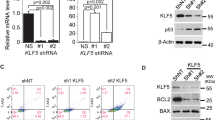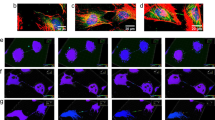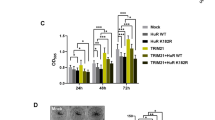Abstract
RhoB is a small GTP-binding protein that is involved in apoptotic signal transduction. We have cloned the mouse RhoB mRNA including a 1377 nucleotide 3′-untranslated region (UTR) that contains six AU-rich elements (AREs) as well as several uridine-rich stretches. There is 94% homology overall between the mouse and rat RhoB genes and 92% homology between the mouse and a putative human clone. Ultraviolet light (UVL) induces RhoB production through regulated changes in gene transcription and mRNA stabilization although the latter mechanism is unknown. We observed that UVL increased the half-life of RhoB mRNA from 63 min to 3.3 h in NIH/3T3 cells and from 87 min to 2.7 h in normal human keratinocyte cells. In vitro mobility shift assays demonstrated that HuR bound the 3′-UTR of RhoB at three distinct locations (nucleotides 1342–1696, 1765–1920 and 1897–1977) suggesting a regulatory role for this RNA-binding protein. HuR immunoprecipitations were positive for RhoB mRNA indicating an in vivo association, and Western blot analysis and immunofluorescence demonstrated that HuR rapidly partitions from the nucleus to the cytoplasm after UVL. Therefore, we propose a model in which UVL induces stress-activated signal transduction leading to nuclear/cytoplasmic shuttling of HuR and subsequent stabilization of RhoB mRNA.
This is a preview of subscription content, access via your institution
Access options
Subscribe to this journal
Receive 50 print issues and online access
$259.00 per year
only $5.18 per issue
Buy this article
- Purchase on Springer Link
- Instant access to full article PDF
Prices may be subject to local taxes which are calculated during checkout








Similar content being viewed by others

Abbreviations
- Act D:
-
actinomycin D
- ARE:
-
AU-rich element
- ERG:
-
early response gene
- EMSA:
-
electromobility shift assay
- ELAV:
-
embryonic lethal abnormal vision
- NHEK:
-
normal human keratinocyte
- PTZ:
-
pentylenetetrazole
- RNP:
-
ribonucleoprotein
- RRM:
-
RNA recognition motif
- UVL:
-
ultraviolet light
- UTR:
-
untranslated region
References
Adnane J, Muro-Cacho C, Mathews L, Sebti SM and Munoz-Antonia T . (2002). Clin. Cancer Res., 8, 2225–2232.
Anonymous (1998). Genome Res., 8, 1097–1108.
Assefa Z, Garmyn M, Bouillon R, Merlevede W, Vandenheede JR and Agostinis P . (1997). J. Invest. Dermatol., 108, 886–891.
Blattner C, Kannouche P, Litfin M, Bender K, Rahmsdorf HJ, Angulo JF and Herrlich P . (2000). Mol. Cell. Biol., 20, 3616–3625.
Brook M, Sully G, Clark AR and Saklatvala J . (2000). FEBS Lett., 483, 57–61.
Carninci P and Hayashizaki Y . (1999). Methods Enzymol., 303, 19–44.
Chen CY, Xu N and Shyu AB . (2002). Mol. Cell. Biol., 22, 7268–7278.
Chen W, Tang Q, Gonzales MS and Bowden GT . (2001). Oncogene, 20, 3921–3926.
Chung S, Jiang L, Cheng S and Furneaux H . (1996). J. Biol. Chem., 271, 11518–11524.
Delarue FL, Taylor BS and Sebti SM . (2001). Oncogene, 20, 6531–6537.
Dixon DA, Tolley ND, King PH, Nabors LB, McIntyre TM, Zimmerman GA and Prescott SM . (2001). J. Clin. Invest., 108, 1657–1665.
Engel ME, Datta PK and Moses HL . (1998). J. Biol. Chem., 273, 9921–9926.
Fan XC and Steitz JA . (1998a). Proc. Natl. Acad. Sci. USA, 95, 15293–15298.
Fan XC and Steitz JA . (1998b). EMBO J., 17, 3448–3460.
Fritz G, Gnad R and Kaina B . (1999). Anticancer Res., 19, 1681–1688.
Fritz G and Kaina B . (2000). Biochem. Biophys. Res. Commun., 268, 784–789.
Fritz G and Kaina B . (2001a). J. Biol. Chem., 276, 3115–3122.
Fritz G and Kaina B . (2001b). Nucleic Acids Res., 29, 792–798.
Fritz G, Kaina B and Aktories K . (1995). J. Biol. Chem., 270, 25172–25177.
Gallouzi IE, Brennan CM and Steitz JA . (2001). RNA, 7, 1348–1361.
Gallouzi IE, Brennan CM, Stenberg MG, Swanson MS, Eversole A, Maizels N and Steitz JA . (2000). Proc. Natl. Acad. Sci. USA, 97, 3073–3078.
Gampel A, Parker PJ and Mellor H . (1999). Curr. Biol., 9, 955–958.
Giles KM, Daly JM, Beveridge DJ, Thomson AM, Voon DC, Furneaux HM, Jazayeri JA and Leedman PJ . (2003). J. Biol. Chem., 278, 2937–2946.
Hernandez-Perera O, Perez-Sala D, Soria E and Lamas S . (2000). Circ. Res., 87, 616–622.
Jahner D and Hunter T . (1991). Mol. Cell. Biol., 11, 3682–3690.
Jiang K, Delarue FL and Sebti SM . (2004a). Oncogene, 23, 1136–1145.
Jiang K, Sun J, Cheng J, Djeu JY, Wei S and Sebti S . (2004b). Mol. Cell. Biol., 24, 5565–5576.
Kasashima K, Sakashita E, Saito K and Sakamoto H . (2002). Nucleic Acids Res., 30, 4519–4526.
Kirigiti P, Bai Y, Yang YF, Li X, Li B, Brewer G and Machida CA . (2001). Mol. Pharmacol., 60, 1308–1324.
Koike K, Uchiumi T, Ohga T, Toh S, Wada M, Kohno K and Kuwano M . (1997). FEBS Lett., 417, 390–394.
Lagnado CA, Brown CY and Goodall GJ . (1994). Mol. Cell. Biol., 14, 7984–7995.
Lal A, Mazan-Mamczarz K, Kawai T, Yang X, Martindale JL and Gorospe M . (2004). EMBO J., 23, 3092–3102.
Lasa M, Mahtani KR, Finch A, Brewer G, Saklatvala J and Clark AR . (2000). Mol. Cell. Biol., 20, 4265–4274.
Levy NS, Chung S, Furneaux H and Levy AP . (1998). J. Biol. Chem., 273, 6417–6423.
Liu AX, Rane N, Liu JP and Prendergast GC . (2001). Mol. Cell. Biol., 21, 6906–6912.
Lopez de Silanes I, Zhan M, Lal A, Yang X and Gorospe M . (2004). Proc. Natl. Acad. Sci. USA, 101, 2987–2992.
Ma WJ, Cheng S, Campbell C, Wright A and Furneaux H . (1996). J. Biol. Chem., 271, 8144–8151.
Ma WJ, Chung S and Furneaux H . (1997). Nucleic Acids Res., 25, 3564–3569.
Malcolm T, Ettehadieh E and Sadowski I . (2003). Oncogene, 22, 6142–6150.
Maurer F, Tierney M and Medcalf RL . (1999). Nucleic Acids Res., 27, 1664–1673.
Mazieres J, Antonia T, Daste G, Muro-Cacho C, Berchery D, Tillement V, Pradines A, Sebti S and Favre G . (2004). Clin. Cancer Res., 10, 2742–2750.
Mellor H, Flynn P, Nobes CD, Hall A and Parker PJ . (1998). J. Biol. Chem., 273, 4811–4814.
Miyakawa Y and Matsushime H . (2001). Biochem. Biophys. Res. Commun., 284, 71–76.
Montero L and Nagamine Y . (1999). Cancer Res., 59, 5286–5293.
Nakamura T, Asano M, Shindo-Okada N, Nishimura S and Monden Y . (1996). Biochem. Biophys. Res. Commun., 226, 688–694.
Park-Lee S, Kim S and Laird-Offringa IA . (2003). J. Biol. Chem., 278, 39801–39808.
Peng SS, Chen CY, Xu N and Shyu AB . (1998). EMBO J., 17, 3461–3470.
Pillaire MJ, Nebreda AR and Darbon JM . (2000). Biochem. Biophys. Res. Commun., 278, 724–728.
Prendergast GC, Khosravi-Far R, Solski PA, Kurzawa H, Lebowitz PF and Der CJ . (1995). Oncogene, 10, 2289–2296.
Schaeffer HJ and Weber MJ . (1999). Mol. Cell. Biol., 19, 2435–2444.
Shao J, Sheng H, Inoue H, Morrow JD and DuBois RN . (2000). J. Biol. Chem., 275, 33951–33956.
Takai Y, Sasaki T and Matozaki T . (2001). Physiol. Rev., 81, 153–208.
Tran H, Maurer F and Nagamine Y . (2003). Mol. Cell. Biol., 23, 7177–7188.
Trapp T, Korhonen L, Besselmann M, Martinez R, Mercer EA and Lindholm D . (2003). Mol. Cell. Neurosci., 23, 302–313.
Trapp T, Olah L, Holker I, Besselmann M, Tiesler C, Maeda K and Hossmann KA . (2001). Mol. Cell. Neurosci., 17, 883–894.
van der Houven van Oordt W, Diaz-Meco MT, Lozano J, Krainer AR, Moscat J and Caceres JF . (2000). J. Cell Biol., 149, 307–316.
Wang W, Caldwell MC, Lin S, Furneaux H and Gorospe M . (2000a). EMBO J., 19, 2340–2350.
Wang W, Furneaux H, Cheng H, Caldwell MC, Hutter D, Liu Y, Holbrook N and Gorospe M . (2000b). Mol. Cell. Biol., 20, 760–769.
Wennerberg K and Der CJ . (2004). J. Cell Sci., 117, 1301–1312.
Westmark CJ and Malter JS . (2001a). Brain. Res. Mol. Brain Res., 90, 193–201.
Westmark CJ and Malter JS . (2001b). J. Biol. Chem., 276, 1119–1126.
Winzen R, Kracht M, Ritter B, Wilhelm A, Chen CY, Shyu AB, Muller M, Gaestel M, Resch K and Holtmann H . (1999). EMBO J., 18, 4969–4980.
Yang C and Carrier F . (2001). J. Biol. Chem., 276, 47277–47284.
Acknowledgements
We thank Dr Henri Furneaux for pGEX2T/HuR plasmid and anti-HuR antibody (Memorial Sloan-Kettering Cancer Center, New York), Drs Syrus Soltani-nassab and Meggan Czapiga for help with the fluorescence microscopy and members of the laboratory, particularly Amit Dande, for their thoughtful comments. This work was supported by National Institutes of Health Grant RO1 MH61666 (to JSM).
Author information
Authors and Affiliations
Corresponding author
Rights and permissions
About this article
Cite this article
Westmark, C., Bartleson, V. & Malter, J. RhoB mRNA is stabilized by HuR after UV light. Oncogene 24, 502–511 (2005). https://doi.org/10.1038/sj.onc.1208224
Received:
Revised:
Accepted:
Published:
Issue Date:
DOI: https://doi.org/10.1038/sj.onc.1208224
Keywords
This article is cited by
-
Targeting the upstream transcriptional activator of PD-L1 as an alternative strategy in melanoma therapy
Oncogene (2018)
-
A recently evolved class of alternative 3′-terminal exons involved in cell cycle regulation by topoisomerase inhibitors
Nature Communications (2014)
-
HuR-dependent loading of miRNA RISC to the mRNA encoding the Ras-related small GTPase RhoB controls its translation during UV-induced apoptosis
Cell Death & Differentiation (2011)


